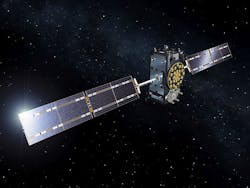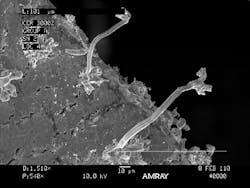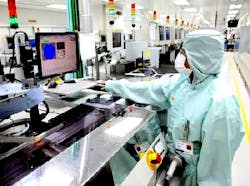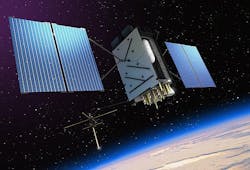COTS/EEE parts in space: component engineering challenges
By Dan Friedlander
Retired following 44 years in component engineering
The use of commercial off-the-shelf (COTS) technologies in space requires a more skillful component engineering approach -- one that includes process control improvements, modern microelectronics packaging technologies, and advanced qualification and testing. Radiation-hardness assurance, counterfeit parts avoidance, and the use of lead-free materials also play key roles.
The parts industry is driven by profit and profit is driven by demand. Technically, profit is driven by more die integration (smaller geometry, 3D transistors) and more die in a wafer (same or larger wafers). For COTS, mainly meant for the commercial market, that means maximum use of die area. This priority has a negative impact on a manufacturer’s decision to sacrifice die area for means to combat space-related threats (SEL, SEU etc.).
The rush to higher part complexity implies more focus on die design and manufacturing. Such complex die cannot be manufactured without continuous statistical process control (SPC) improvements.
Developments in die packaging technologies, like stacked silicon interconnect (SSI), pose further challenges to component engineering. Traditional space parts lag generations behind these already available technologies.
Market forecast
The only thing certain about the semiconductor market is uncertainty. The uncertainty stems from both users and manufacturers.
Military and space components’ market share (as measured in dollars) of the global electrical, electronic, and electromechanical (EEE) components market is less than 0.5 percent. The question is: How long this market is viable?
Two factors determine the answer:
a. Users
What is the actual use of the miniscule population of the space and/or military components? There are at least four types of applications using space and/or military components:
- Space applications working according to the tradition.
- Old military applications, not being able to switch to COTS.
- New military applications, caught in dilemma of reuse/new design.
- New military applications, not committed to the US Perry 1994 directive to use COTS.
Knowing the above use distribution may help to forecast the market demand size and schedule.
b. Component manufacturers
Based on history, we have learned at least two basic facts:
- Keeping in parallel two infrastructures for military/space components and COTS is a burden for the manufacturer.
- Nothing can stop business decisions by components manufacturers.
The space and military components market viability is finite. Use of COTS is the only known alternative.
Read all three parts of the “COTS/EEE parts in space” series by Dan Friedlander
Lots homogeneity
Lots homogeneity is a very important factor in assuring part radiation-withstanding assessment, and a key factor in assuring sample testing efficiency.
COTS are traceable to date code (not to wafer), representing the timing of packaging. It has to be said that military parts, allowed for space use, are also only date-code traceable. The high production volume and manufacturing improvements due to SPC yield a very narrow distribution for a component lot.
Other component industry trends work in favor of decreasing the probability for lot-to-lot variations:
- Component manufacturers mergers resulting in less foundries for a given component.
- Increased number of fabless companies, achieving a more centralized production of several manufacturers.
They are negative factors impacting the COTS lot-to-lot variations:
- Multiple production lines for the same manufacturer, same component.
- Outsourcing of the manufacturing phases of die production packing and testing to multiple locations and/or entities.
- Wafer Traceability versus date code.
Radiation hardness assurance
This domain needs to be revisited. In view of the industry trends mentioned above, the costly lot-by-lot radiation testing requirement has to be tackled.
Counterfeit parts avoidance
Counterfeit parts activity is a lucrative one – and problematic for space applications. Counterfeit parts present a global problem in need of solutions.
All quality levels of EEE parts may be affected. Components engineering shall take proactive steps to assure use of authentic parts.
Use of COTS in space requires even more awareness. A proper selected and controlled supply chain combined with relevant authenticity related documentation (e.g., Certificate of Conformance (CoC), etc.) is a key factor to avoid introduction of counterfeit parts into operational systems.
Use of lead-free COTS
The global enforcement of the Restriction of Hazardous Substances (RoHS) Directive poses an obstacle to be overcome. The main concern for the EEE parts is the replacement of lead containing parts with lead-free parts. As a result, the tin whiskers issue is raised and the parts soldering into boards assembly process has to be adapted accordingly. The higher risk of whiskers growing in vacuum further requires special attention.
Components engineering shall be able to find solutions within the Parts Control Plan. Knowledge of the exact chemical content of the parts leads (e.g., prime source part manufacturer) and mitigation actions by part manufacturer to prevent growth of whiskers (in case of lead-free part) is a key element of the part’s approval for use.
The use of selected lead-free COTS in space is inevitable. The availability of lead-containing leads finished parts is continuously diminishing.
Depth of post-procurement testing
The depth of the post-procurement testing of COTS for space shall consist of value-added activities needed to reach an acceptable level of mission success confidence. The potential damage to the actual flight parts, during handling and testing, shall be given high priority. No 100 percent testing shall be done.
Interalia, the mechanical integrity of the package (especially for the smaller and smaller package/leads pitch geometry) is vital for achieving reliable solder connections.
The electrical testing of the more and more complex parts becomes more and more difficult and inefficient. No other entity outside the part manufacturer has the full knowledge needed to efficiently test those complex parts.
Obsolescence
EEE parts obsolescence hits the military, space, and commercial market. It has a costly, complicated, and risky impact.
In the military, massive EEE parts obsolescence occurred due to part manufacturers’ decisions to leave this market or reduce the activities.
In the commercial market, due to the high dynamics in technological development, the availability period of COTS is often shortened.
Proactive mitigation actions have been developed to manage the obsolescence issue. At least the obsolete COTS in space orbit do not need obsolescence-related attention for maintenance or repair purposes. Nevertheless, attention shall be paid to follow-up designs.
Risk Management
Risk management does not mean going after a proved, traditional methodology not compatible with the present reality. It means managing the risk within a new methodology that can meet the present and future reality. Such a new policy means reversal of the EEE parts selection priority: first selection priority should be given to COTS. In order to meet the requirements, "brainstorming" is required.
NASA PEM-INST-001 Instructions for Plastic Encapsulated Microcircuit (PEM) Selection, Screening, and Qualification states:
"Product assurance methodology of most PEM manufacturers is based on the philosophy that the reliability must be designed or built into the manufacturing process rather than achieved by 100 percent testing of products. According to this methodology, the emphasis is on increasing the yield and reducing the likelihood of defective parts production by tight process control rather than on detection of failures during electrical testing.
"The qualification and screening processes contained in this document are intended to detect poor-quality lots and screen out early random failures from use in space flight hardware. However, since it cannot be guaranteed that quality was designed and built into PEMs that are appropriate for space applications, users cannot screen in quality that may not exist.
"Testing may not guarantee the same level of reliability offered by military microcircuits.
"Unlike the military high-reliability system, users of PEMs have little visibility into commercial manufacturers’ proprietary design, materials, die traceability, and production processes, and procedures. There is no central authority that monitors PEM commercial product for quality, and there are no controls in place that can be imposed across all commercial manufacturers to provide confidence to high-reliability users that a common acceptable level of quality exists for all PEMs manufacturers. Consequently, there is no guaranteed control over the type of reliability that is built into commercial product, and there is no guarantee that different lots from the same manufacturer are equally acceptable. And regarding application, there is no guarantee that commercial products intended for use in benign environments will provide acceptable performance and reliability in harsh space environments."
The above statement shows that the COTS methodology is well understood by policy makers. The only problem is how to implement COTS methodology in space applications. The use of the wording "guarantee" is inappropriate. There is no doubt about military/space parts being acceptable in space applications; their reliability is acceptable. However, no central authority control and/or 100 percent testing imposed requirements can guarantee the level of reliability and quality of the EEE Parts, including the space/military ones.
The goal is not to reach the same level of reliability offered by space/military microcircuits. The goal is to reach an acceptable level of reliability, within the technical, commercial, and financial constraints.
In order to meet the acceptable level of the reliability and quality, there should be a creative methodology of reliance on selected COTS manufacturers` Quality Assurance (QA) – including process-related activities, electrical testing, environmental testing, reliability monitoring program, qualification, etc. – of minimum acceptable post-procurement activities (radiation testing if applicable, DPA, etc.) and of pragmatism.
Even the MIL authorities realized that the "cookbook" era of MIL-SPEC is over and the performance-based era is the one to be practiced.
Technically, selected COTS use in space is viable in space applications. Revisiting the traditional methodology of EEE parts control may lead to a more realistic one.
The name of the game is risk management based on engineering judgment and based on lessons learned.
Following the present COTS (especially PEM) official methodology the challenging goal of building sophisticated, small, light, cheap satellites (especially for mega constellations) will become a theoretical target. It seems that the present target is $500,000 per satellite. This sum is not achievable within the range of the present requirements for EEE Parts.
EEE Parts is only a small part of a satellite cost. Consequently, the need to revisit traditional methodologies in the space industry applies to all domains.
NASA PEM-INST-001 also states: "PEMs should only be used where due to performance needs there are no alternatives in the military high-reliability market, and projects are willing to accept higher risk."
Why is use of PEMs automatically a higher risk? Maybe one complex PEM can implement a function implemented by an entire board of parts found in the military HI-REL market? Why is a PEM instantly labeled as a not high-reliability part?
The answer is that we are still stuck in the philosophy of the space/military-level parts traditional methodology of penalizing the PEM for space application. Nevertheless, some conditional limited go ahead for using COTS in space is given. The condition is very easy to be fulfilled, in view of the demanding requirements of high-performance, small, light satellites. The designers will find a justification of "no choice" for selecting advanced COTS. Ironically, these advanced COTS, selected as "nonstandard" parts will function as the heart of the system!
Cost reduction
Space is a very demanding domain. The technical requirements to be met for COTS in space shall be established and implemented within the available budget limitations. Consequently, testing optimization is needed to reach an acceptable level of mission success confidence.
The term "testing optimization" is also applied in the QML methodology, applicable to space- and military-qualified parts. The "enough" target is targeted, not the best one. In order not to misunderstand the term "cost", it should be emphasized that for an EEE part the following applies:
Part Ownership Cost = Part Procurement Cost (RE) + Part Post Procurement Cost.
The main cost drivers are:
Cost Driver | Cost Mitigation |
Part Procurement Cost | Consolidation of Parts Orders |
Part Post Procurement Cost | Depth of Testing Optimization |
Often (especially PEMs) the COTS Parts Ownership Cost, following the quasi-traditional methodology (like NASA PEM-INST-001), is higher than that of Space Parts. A higher integration of COTS may alleviate such cost comparisons by taking into account the cost of all the space parts functionally replaced.
The cost-saving aim (by the Perry directive) to using COTS in military applications is obtained by using them AS IS (without extra post procurement testing). This is not the case for space applications. In order to reach cost reduction, the NRE in the part ownership cost shall be optimized. This can be obtained by eliminating non-value-added, post-procurement testing activities.
There is substantial potential for cost reduction if certain traditional topics are revisited and conclusions drawn. The procurement strategy shall be also weighed in this context.
COTS selection for space
The proper COTS selection for space is the most demanding challenge. The task requires multiple professional skills and a variety of data related to COTS selection for space to be found or generated. The main data to be analyzed are: radiation withstanding, lead finish, whiskers potential threat, part heritage, part manufacturers’ generated qualification data, reliability reports, part specification (data on package, lead pitch, etc.), part technology/process-related data, compatibility with the intended soldering process, availability, etc.
The part manufacturer has to be selected, as well. It is obvious that not all COTS manufacturers are best in class or should be selected to supply product for space applications. At the same time, a given part might be suitable for use in space, but not in all space applications. The selected part shall meet the specific mission requirements.
Conclusion
The introduction of COTS in space applications is unavoidable. In turn, component engineering for space applications faces new challenges.
The author has graduated ENGINEERING SCHOOL/TEL AVIV UNIVERSITY, physics 1965-1969. He has 44 years of experience in Component Engineering at MBT/ISRAELI AEROSPACE INDUSTRIES, 1969-2013, as Head of Components Engineering. He was responsible for all aspects of EEE Components (policy making, standardization at corporate level, approval, etc.) for military and space applications. Retired/Consultancy: 2013 - present. Further details of experience: see https://www.linkedin.com/in/dan-friedlander-63620092?trk=nav_responsive_tab_profile
Search the Aerospace & Defense Buyer's Guide
The go-to resource for Intelligent Aerospace technology news & information:
Covering key topics
Across all market segments
Subscribe to the free Intelligent Inbox e-newsletter
Subscribe to receive all the latest aerospace technology news & information, delivered directly to your e-mail inbox twice a week (Tuesdays and Thursdays). Sign upfor your free subscription to the Intelligent Inbox e-newsletter at http://www.intelligent-aerospace.com/subscribe.html.
Connect on social media
Keep pace with aerospace innovation and opportunities via your favorite social media channels. Connect with Intelligent Aerospace on Twitter (@IntelligentAero), LinkedIn,Google+, and Instagram.







